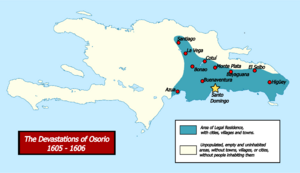Devastations of Osorio facts for kids
The Devastations of Osorio (in Spanish, las Devastaciones de Osorio) describe a time in the early 1600s on the Caribbean island of Hispaniola. The King of Spain, Felipe III, wanted to stop illegal trade in the northern and northwestern parts of the island. So, he ordered the governor of Hispaniola, Antonio de Osorio, to move everyone from those areas. They had to move closer to the capital city, Santo Domingo, in the southeast. This forced move happened between 1605 and 1606.
Contents
Why the King Ordered the Devastations
In 1604, King Philip III of Spain noticed that he was losing control over the northern and western parts of Hispaniola. People there were trading illegally with French, English, and Dutch ships. This was called contraband or smuggling.
The king wanted to stop this illegal trade. He also wanted to prevent his Catholic subjects from having contact with people he called "heretics" (people with different religious beliefs).
The Problem of Smuggling
The people living in areas like Puerto Plata, Montecristi, Bayajá, and Yaguana were trading their goods. They mostly sold cured meat and animal hides. In return, they received smuggled items from foreign traders. This illegal trade had been going on since the mid-1500s and was growing fast.
The king's order meant that these areas, where smuggling was common, had to be emptied. The people living there would be moved closer to Santo Domingo, the island's capital.
Governor Osorio's Difficult Task
When the people in the northwest heard about the king's order, their town councils tried to stop it. They sent many requests to the king. However, Governor Osorio had to follow the royal order exactly.
In early 1605, royal officials went to the northern part of Hispaniola. They told the people that they would be forgiven for breaking the king's rules by trading with foreigners. But there was one condition: they had to gather all their belongings, slaves, animals, and other property. Then, they had to move to new places in the southeast, chosen by the royal authorities in Santo Domingo. Some Spanish officials tried to stop this order because their own smuggling businesses would be hurt.
Forced Relocation and Destruction
The people in the north did not want to leave their homes. So, Governor Osorio had to ask for more soldiers to make them obey the king's order. Help came from Governor Sancho Ochoa de Castro in September 1605. He sent 159 soldiers from San Juan to Hispaniola.
These soldiers, led by Captain Francisco Ferrecuelo, went to the north of the island. They forced the people to leave their farms and homes. To make sure no one stayed, the soldiers destroyed sugar plantations. They burned huts, ranches, large farms, and even churches. They broke down everything the villagers needed to live in those places.
The main areas that were emptied were Puerto Plata, Montecristi, Bayajá, and Yaguana. By January 1606, Governor Osorio wrote to the king. He said the destruction was mostly done. He just needed to finish moving the cattle herds. The whole process lasted until the middle of 1606.
Eventually, the governor created a border. It stretched from Azua in the south all the way to the north coast. He told the Spanish people that they could not cross this border. The people from Bayajá and Yaguana were moved to a new town called Bayaguana. Those from Montecristi and Puerto Plata were moved to Monte Plata.
Results of the Devastations
Governor Osorio's plan did not stop smuggling in the region. In fact, it caused many problems.
Economic Disaster
About 120 herds of cattle, totaling over 100,000 cows, pigs, and horses, were destroyed. Only about 15% of these animals could be moved to the new locations. The rest were left behind and became wild.
The destruction of sugar mills also hurt the sugar industry. This, along with the loss of livestock and plantations of cane and ginger, made the island much poorer. Santo Domingo became less important in colonial trade.
New Opportunities for Others
The emptying of the northwestern part of Hispaniola created new opportunities for others. Many runaway slaves settled in this empty region. These runaway slaves came from Hispaniola itself, and also from nearby Cuba and Puerto Rico.
Also, the king had hoped that the abandoned territory would be forgotten. But instead, foreigners took advantage of it. They benefited greatly from the wild cattle and other resources left behind by the Spanish. Over time, these foreigners, mainly the French, settled the abandoned land. This led to the creation of the French colony of Saint Domingue. By the 1700s, Saint Domingue became one of the richest colonies in the Caribbean, famous for its sugar and coffee plantations.
Impact on the Spanish Crown
The poverty caused by the Devastations of Osorio also affected the colony's tax money. There wasn't enough money to pay for government workers or to keep the army in Santo Domingo.
The Devastations of Osorio showed the start of a stronger Spanish military presence on Hispaniola. To carry out the order, 159 soldiers from Puerto Rico were needed. The terrible economic impact eventually changed how Hispaniola was funded. Money started coming from the viceroyalty of Peru instead of the viceroyalty of New Spain. However, from the 1680s, the growing threat from buccaneers and French forces meant Hispaniola and Cuba received a lot of money from New Spain, mostly for military needs.
Historians agree that the Devastations of Osorio were a mistake. They did not help the colonists or the Spanish Crown. Instead, they left the island's economy in a crisis that lasted for many decades. They also allowed Spain's enemies to settle the abandoned territory.
See also
 In Spanish: Devastaciones de Osorio para niños
In Spanish: Devastaciones de Osorio para niños


